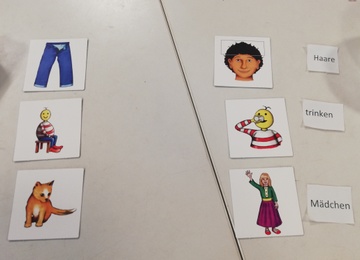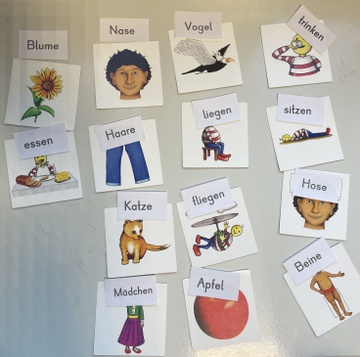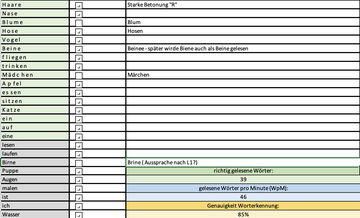Primary School: Reading Tandems
Description of the teaching development project on “reading tandems”
Title: “Reading tandems for all children?”
Development goals
- analysis and adaptation of the “tandem reading” method so that it contributes to reading support in the classroom for all pupils (especially those with little knowledge of German)
- development of recommendations for the teaching staff for the use of the method
Teaching measures
First, the method was tested as recommended in the literature and by the Senate of Berlin: The “trainer-athlete principle” was applied and the composition of the pairs was based on a relatively strict allocation pattern according to reading competence (1st intervention).
After the 2nd diagnosis, the method was adapted for the class: Instead of the “coach-athlete principle”, the teacher introduced “shared reading” without hierarchy and with three simple rules. New, simpler cards were created for children with lower reading skills. There was also a focus on the matching in the tandem pairs in terms of social and motivational aspects; once a week, the children were allowed to choose their partners freely.
Example of a new card at an easy level (Photo: L. Hartmetz)
Accompanying research/ evaluation
The effectiveness of the first intervention (IV) and then the second intervention were tested using three diagnoses (D; sound reading protocol, picture naming, picture matching) at intervals of approx. 4 weeks. The sequence was therefore D1 - IV1 - D2 - IV2 - D3.
The diagnoses were used to assess the progress that the children were able to achieve with the help of the 1st and 2nd intervention in the area of reading fluency, but also more fundamentally in the area of vocabulary (receptive, productive). One focus here was on children with German as a second language.
In addition, observation notes and vignettes were created during and after the observations of the tandem phases in class, with a focus on the children's collaboration in the tandem. They served as qualitative data to supplement the diagnostic tests.
After the second intervention, the teacher conducted a “dot survey” on the method with all pupils (see photo) as well as short pupil interviews with the children with German as a second language in order to capture their assessment.
There was a regular exchange between the teacher and the two researcher-students as well as the project leader regarding the results of the above-mentioned data collection.
Diagnostic material (Photo: C. Saunders)
Example of diagnostic results (Photo: N. Hinz)
Example of evaluation form (Photo: N. Hinz)
Results
The student survey revealed a mixed picture of approval and disapproval of the method. The children saw the connection between practicing in tandem and learning to read and tended to find the second, adapted method better. In the discussions with the children with German as a second language, the teacher learned that they were very aware of their own language skills and preferred learning techniques, and that they were able to express their needs. The social factor in the tandem played a major role for them.
Results of the pupil "dot survey" (Photo: K. Eichhorn)
The following is taken from the researcher-students' results report regarding reading progress:
All observed children showed an increase in reading speed and/or reading accuracy and/or vocabulary over the course of the study period.
The data showed an increase in learning in the first intervention and the second intervention. The children preferred the principle of reading alone/alternately/together (2nd intervention) to the “trainer-athlete principle” (1st intervention). Nevertheless, the children also benefited from the trainer-athlete principle (comparison D1-D2).
Hypothesis: The reading aloud method works, even if it is “not much fun” to carry out.
According to the data, there is nothing to be said against involving the children in the design of the reading tandems to increase motivation, as it is effective even then (comparison D2-D3). Whether there are gradual differences cannot be conclusively assessed due to the small amount of data.
In some children with very low reading skills, an increased motivation to read and even to participate in the diagnoses was observed, which could be attributed to increased self-confidence in reading. In tandem, these children and their classmates sometimes used additional communication strategies, such as asking questions or explaining the meaning of words. There were indications of a growing sensitivity of individual L1 pupils towards the situation of their classmates with L2 German.
With regard to the factors influencing the choice of partners in reading tandems, the following possible factors were identified through the exchange between the four researchers:
- Reading competence, ability to concentrate, social skills, first/second language German, personality (e.g. patience, empathy), “motivational skills” (being able to motivate others to participate/read), urge to move (physically rather calm/restless), friendly relationship between the partners, level of difficulty of the card/text (fit with the skills of the weaker reader), even/odd number of pupils (tandem/tridem), self-image of the children (e.g. in the “teacher role”) and associated with this: definition of the tandem as “athlete/coach” setting or preference of “shared reading”
Developed recommendations for the use of the method at primary level in linguistically heterogeneous classes:
- involving the pupils in new processes: choice of texts, choice of partners
- finding fixed places to practise
- asking for regular reflection rounds or feedback (student perspective)
- continuing to randomly check reading speed and accuracy while reading aloud: implementation of only 1 minute, possible during ongoing lessons
- considering scientific research into social influencing factors in reading tandems (see list above)





